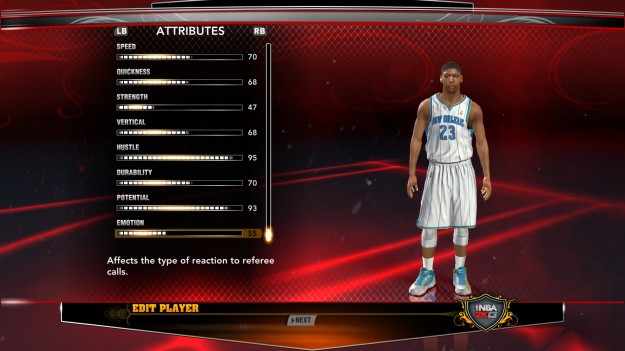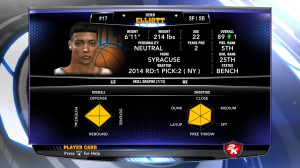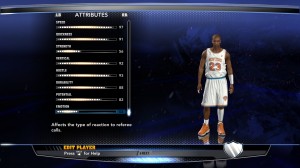(Note; This post is a draft and was written several months ago but never published, for reasons that will become clear in the next post I write. So, the second part of the series was left as a draft and I never tidied it up for publication. I’m publishing it “as is” just so I can move on with a few edits! It is still a bit “wordy” and due to the time its spent unpublished, some of the information might be out of date. It just seems a shame for it to go to waste, and I still have hopes for writing additional parts to this series).
You could use ANY team in the game for this project (just blow the team up and trade for 1 year contracts), but there are good reasons why both of these teams are suggested and combined into one post (rather than just one team, which would be, and will be, the norm); first they are both THE biggest market/dollar value NBA teams, and in 2013 they became the first teams to be valued at $1 billion (per Forbes). They are both teams who are expected to be well into the luxury tax, pushing the hard cap (for those who skipped part 1; we are aiming for a level of realism in this series of challenges. While Utah Jazz may have to be worried about hitting luxury tax, or straying too far from the soft cap, these teams are the polar opposite and will spend, spend, spend to get the best players and supporting cast!).
Most importantly, for the purposes of picking a team to play as in Association Mode (or My GM), they are both heading into a year (2014 for the Lakers, and 2015 for the Knicks) when all of their big contracts end, effectively leaving them with a clean slate. Both teams will almost certainly attempt to lure some marquee free-agent signings to create a Heat-alike big 3 (and speaking of Heat, the future of both teams may rest on the decisions made in Miami). I said in part 1 that we were aiming for an OKC Thunder (slowly acquiring young players) type project, this is a very different challenge (and one that I suspect will appeal to more people), this IS a Miami Heat project; bringing 3 or 4 of the best players in the game together to form a super team.
Throughout 2013 there was much talk of the 2014 free-agency being one of the most exciting in NBA history. Some of the names mentioned included; Paul George, Loul Deng, DeMarcus Cousins, Greg Monroe, Dirk Nowitzki, Kawhi Leonard, Carmelo Anthony, John Wall, Dwyane Wade, Lebron James, Chris Bosh, Tim Duncan, Danny Granger, Paul Pierce and not to mention the entire Lakers squad (almost), including Pau Gasol and some guy named Kobe Bryant (and that is a tiny sample!). If you search the internet you’ll probably find all of the names have been mentioned in the same breath as the Lakers at some time or another over the past few months. Of course, the reality is, many of those supposed “free-agents” either have a team option, a player option, were (in the case of Cousins, Wall and George … and as I write this I can add Favors to the list) signed to massive contract extensions in the off-season, or were restricted free-agents so wouldn’t move (as has been shown by the max contracts given to Wall and George, even if a team had come in for them, their own teams would have matched the offer anyway).
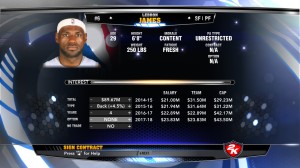
Lebron 21 million contract
From the list above there is still a lot of quality available in the 2014 free agency (although the 2015 F/A is potentially even more packed).
Obviously the biggest name in the hat is Lebron James (I’ve played a few games of association mode, going a few seasons deep and I tried to work out if there were conditions that made Lebron use his player option to leave Miami. At first, I thought he would leave if Miami didn’t “three-peat”, but I’ve seen him not enter free-agency when Miami got knocked out in the early rounds (annoyingly; while playing through as the Lakers on the first occasion for this very article!), and on another occasion I saw him exercise his player option after Miami won the title. So, make of that what you will (it appears to be somewhat random!).

Ed Davis, Knicks, 490K 5 Year deal.
It goes without saying; if Lebron becomes available you should go all out to get him! He’s the best player in the game today and by the time he’s retired he may be in contention for being talked about in the GOAT conversation. He is THE franchise cornerstone for any team in the game and will remain the best player in the game for at least another 4 or 5 years (unless you drastically train up another player to overtake him!). Most importantly of all; he’s crazy fun to play with in any team. He improves the whole squad and can play in either forward position. When he does become available, there is (as you might well expect), a lot of competition to get him and pushing the slider so it’s full (starting at around $21 million with a backloaded contract – see screenshot) doesn’t even guarantee he’ll sign for you!).
That screenshot was a second play through with the Lakers for this article, and this time Lebron DID become available but signed for the Phoenix Suns! If you want to be sure of landing him you’ll probably need to offer more than $21 million! I’ve yet to see Melo enter free-agency, EVEN when I played a game through as the Knicks (again, in preparation for writing this), and trading away half of the first team for players whose contracts were running out in 2014 (I was attempting to resign a few half-decent players on 490K 5 year deals to use as squad players for the upcoming 2015 free-agency dream-team I wanted to build – see screenshot above).
Additional note (Feb 2014): I did manage to sign Lebron using MLE one time using the Pacers after winning the title with them in the first year! See screengrab (this is the subsequent season, he signed a 3&1 deal). This was a freak occurrence! Something I’ve never seen happen before or since; so I wouldn’t expect this!:

Lebron James – MLE Pacers
Pre-“Super Team” Trades and Contracts
Any trades you do in 2013/14 want to be for fresh rookies or expiring contracts who might accept a 4/5 year flat contract at $490K (you’d be surprised how many players accept this contract – far too many to be realistic. I’ve had Ed Davis, Evan Turner, Hayward, Lowry and even, as unlikely as it sounds, Greg Monroe on 4 or 5 year $490k flat contracts!). You can get some absolute gems to use as squad players from these expiring contracts; I try to take at least one or two expiring contracts through each term with the sole purpose of attempting to negotiate a $490K contract (should they go to free-agency or another team offers them a higher contract I ditch them).
You should avoid the temptation to blow the team up and get high draft picks in the first season (by all means blow the team up, just try to trade draft picks for the year following your big free agency signings). A few of those early round draft picks can add up to a significant cash amount! You should also be aware of player options (very easy to miss when signing expiring contracts) and also, if possible, avoid offering qualifying offers for players prior to free-agency as these amounts will be deducted from your budget!
2013 Season
I honestly didn’t play through much of the 2013 season (I played a couple of games during the season, and played through the finals during a run-through with the Knicks, but sim’ed through the rest. It isn’t worth playing many games because you might hit free-agency and get a load of duds instead of the big names! So keep this season short and sweet and only use training drills on exceptional rookies who are keepers.
2014 Free Agency

2014 NBA 2K Free Agency
We’re really talking about the Lakers here as they have the 2014 cap space (If you’re the Knicks skip this bit as you can only afford a luxury tax MLE signing, make it a cheap one and preferably a one year deal, sim the next year and read the next section! Unless you blew up the team of course).
If everything goes to plan Lebron declined his option! Finally (in my game) he’s available! Game on! The 2013 draft is really all about Lebron! What to do if he decides to stay with the Heat? Restart? Carry on playing and see if you can pick him up in free-agency next year or via trade? Your call! You could try for a few of the decent restricted agents and see what your team looks like going into ’14. The reason I suggested not playing too many games and not going too crazy in training is so it didn’t take long to get to this point. Hopefully it will only take you a couple of minutes game time to get to 2014 free agency, so you can restart again if need be and just sim back here again if the free-agency doesn’t work out for you.
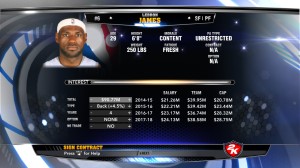
Sign Lebron – Free Agency 2014
The (first) big question is whether to keep Kobe? It seems almost sacrilegious to get rid of him from the Lakers (and to see him playing in another jersey would be just weird! I’m sure every Lakers fan is throwing things at the monitor at the very mention of this even being a dilemma!). If you offer him a 5 year Bird deal with a player option you can start at around $11 million (rising to over 15 million in his 5th year. A lot of money for what will be a 40 year old player!). You can, of course, trade him prior to him hitting that age/wage, and there’s also a good chance he’ll retire by then anyway. At this stage of the game he’s rated (without me running him through any drills during the season) at 92, and is the second best SG in the game (after Harden), and the 8th best player in the NBA overall (and this after the game has deducted points off him due to reaching the end of the season and gaining a year).
So perhaps that $11.5 million deal suddenly doesn’t look so bad does it? I’d say he’s a keeper (you might disagree and want to go younger/cheaper – go for it! There really isn’t a right or wrong answer to this one and I think in the real-world it would be more likely that Lebron would join the Lakers without Kobe than with – for reasons beyond the scope of this post). I offered the rest of the squad who weren’t going FA the minimum salary ($490k), in the end 3 players took the offer, including Nick Young, so not too bad. Those who do accept will fill one of the 12 required positions without taking up valuable cap-space, so offering any half-decent player a minimum contract is a no-brainer here.
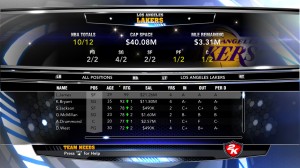
Lakers 2014 partial squad
I managed to flip the 3 remaining contracts (Nash, Sacre and Leuer) for Drummond and a draft pick swap (I think I had 17th, and Pistons had 19th, so no great loss!) during the draft. I also had some other mid-round picks, which worked out quite well, as the goal is to end free-agency with 12 players but by spending as little as possible on them (so certainly not $4 million on a first pick rookie – unless he’s a locked in superstar of course!). I actually did quite well with 2 of my mid-round picks, picking up a 78 rated SG/SF and a 20 year old 70 rated SG/PG with A+ potential (the third was a bust, an early 60s PF who I used later to boost a trade). So things prior to free-agency were looking good!
The 2014 free-agency is a bit barren (unless the Heat players use their player-option and enter free agency), especially compared to NBA2K13 when you could get two players (Howard and Paul) who are the best in their respective positions and were going free in the 2013 free-agency (and you could oftentimes pick up Melo in the following free-agency for your MLE – giving you one hell of a “big 3” to build around/with and just enough cap-space to fill the squad with some quality too!).
BUT, if you have the cap space available and Lebron makes himself available for this free-agency period you have the best player in the game today (the best player in the game since Jordan, and perhaps the GOAT!). Adding Howard/CP3 to your team in 2013 was great, adding Lebron in 2014 is amazing!
IF you can get him for around $20 million you’ll have done well (on the third play through (the things I do for this blog!!!) I maxed out the offer, which was only just over $21 million, and he signed straight away. Unless there is another major star on the market (Deng is often available, reasonably cheap at $5 million-ish, but has the disadvantage of playing the 3 spot, meaning you’d have to play Lebron in the 4 instead of as a SF-point forward. Granger is also available but again plays in the 3/4 positions), your best option is to sign a squad of players on 1 year deals, unless you can get a bargain player over 4 years (for LOW money. I.E a 70+ player, who is less than 28 years old, and will take less than $2 million per year). This will leave you with the opportunity to flesh out your squad in the more heavily packed 2015 free-agency, building another “Big 3” (and maybe even a “Big 4” and ultimately a “Big 5”).

Lakers Starters 2014 – note: Randolph was a trade for Brand.
Monroe is available, he’s certainly a star-caliber player and is value at around $8 million, sadly he’s a restricted free agent. I offered $9 million on the off-chance they wouldn’t match the bid, they did! I didn’t want to go to crazy as I still only had 4 players (the 2 draft picks, Drummond and Kobe, with Lebron still deciding). I managed to pick up Lowry (PG), Brand (PF) and Varejao (C), effectively giving me a starting 5 (with Lebron and Kobe). I missed out on some other big names (e.g., Gortat) by trying to skimp, but still landed a couple of others who I can hopefully package up and combine with the players just mentioned to trade up when the season starts.
It is tempting to pick up all the half-decent players and then trade them up for a second star player when the game ticks over into the new season. If you are going to do this you should try and sign the players on a one year contract (you’ll pay more but they’ll become available in free-agency next year, again!). The problem with doing this is cap-space, it limits you to one major free-agency signing. If you just want to sign Lebron, and some supporting cast and then go from there then by all means go down this route. If you’d prefer to go after a Heat-style free-agency “big 3” type signings, then you’ll need to watch every dollar you spend between this free agency (where you landed a star player) and the 2015 free agency (where you can hopefully add 2 more!). Talking of which….
2015 Free Agency

Kobe 36 – Still Going Strong
I hit 2015 playing (first) as the Knicks. Stupidly I’d ignored my own advice and had a bit of fun trading away players and building a squad (which I had to practically give away for future trade picks in the 2016 draft; where I’m now due about 20 players!). I’d even traded away Melo, hence his inclusion below (I had to account for people who had gone with the Lakers and followed my advice to sign the supporting cast on 1 year deals to leave space for a star or two in 2015 as well – this is the chance to have a big 3 with Melo and James running the 3/4 spots!).
As you will see, the 2015 free-agency is filled with far more talent (as contracts and extensions for that year haven’t occurred yet!). I did some sums (and messing with the sliders), adding player bonus years and in one case a no-trade clause for a player was necessary to bring the salary down enough to make 5 players (and only 5 players!) fit into the $60 (odd) million soft cap. On my play-through these were the best players I could fit/find (but see below), it may differ on yours and it’s entirely possible that Lebron (and the rest of the Miami core) could enter F/A here too (if he didn’t in 2013) as both of his final years are player option years:
1. Rondo (90) (*)
2. Kobe (36 years old, but still has an 89 rating!)
3. Rudy Gay (87) (**)
4. Carmelo Anthony (92)
5. Chris Bosh (83)
.. but signing all of those 5 players would mean starting with zero contracted players (you’d literally have to get rid of any and every player and start with a zero $ balance) and then try to fill out the remaining spots (at least 7 players!) with the Mid-Level Exception, and some players would have to be picked up on the league minimum to fill in all the spots.

2015 Free Agency – that’s just the start of a BIG list!
Still, as “Big X” teams go, that starting 5 doesn’t look too bad! I’ll let you decide if it’s a big 2,3,4 or even a 5! (of course, it’s entirely probable the 2015 free agency will look very different in your game. Different teams make different moves. Different players take up contract options/refuse player options, etc. I had half hoped that Kevin Love would be in this list but he took up his player option!).
That is, of course, the base with which to start your team. Kobe wouldn’t be a long term solution (and tbh, I’d probably have gone for a cheaper, younger player further down the list and used the money I’d saved to flesh out the squad a bit). All of those players are quite old, over 30 in 2015, had we tried to buyout some restricted free-agents we could have gone with a younger squad (all under 25) which is still improving. This would look something like this:
1. Kyrie Irving(*)/Ricky Rubio (92/85)
2. Jimmy Butler (83)
3. Tobias Harris (78)
4. Kenneth Faried (84)
5. Nikola Vucevic (78)
(*) – Note: Kyrie would have been in the team above instead of Rondo (he has better stats and is younger), but it wouldn’t have worked financially. Kyrie is a restricted free agent (all the players in the first list are unrestricted), and you will need to offer a minimum of $20 million (and even then it’s likely the Cavs will match the bid), compared to $14 million for Rondo.
(**) – This was written when Gay was at Toronto. He was a 4 1/2 star player back then, so worth acquiring to trade, if for no other reason (in truth he’s not bad in 2k! His real life “inefficient, low-percentage, chucker” problems don’t translate into the game, unless you play NBA 2K as an inefficient, low-percentage chucker! He’s never worth 4(+) stars though!).
2016 and Beyond
Regardless of what happens in the 2014 or 2015 off-seasons, you should always be looking to trade up your squad. Can you replace your 37 year old SG (no names mentioned!) with a 23 year-old with similar stats (and a rookie wage)? That PF you had to acquire as a compromise to assemble the rest of the squad, can he now be combined with another player (or two, or a pick) and upgraded?
This is your chance to play some fantasy NBA and go for the best of the best (rookies and veterans). Assemble the best group of players and always treat them as tradable assets. If you have a chance to upgrade, do it (although always take age/potential into account! See previous post).
As well as acquiring the best players of today, the big (and most successful!) NBA teams brought players through the ranks. Getting the most promising rookies (who complement, or can fit into the starting 5) should be your priority once you’ve assembled your super team.
Both of these teams will be looking at going deep into luxury tax long term and turning those rookie contracts into full player deals is a surefire way to do that. Reaching the top (hard) salary-cap and keeping a team together is a challenge in itself, especially if you have world-class players and expiring contracts!










